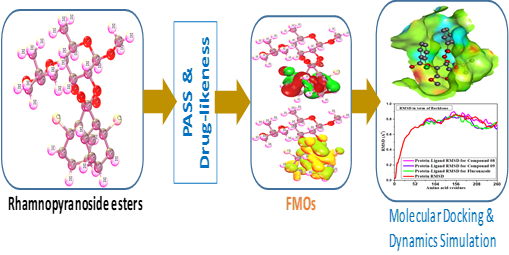Rhamnopyranoside Pivaloyl Esters as Black and White Fungus Inhibitors: Molecular Docking, Dynamics and ADMET Analysis

- ADMET,
- Antimicrobial activities,
- DFT docking,
- Molecular dynamics,
- Rhamnopyranose esters
Copyright (c) 2024 Orbital: The Electronic Journal of Chemistry

This work is licensed under a Creative Commons Attribution-NonCommercial-NoDerivatives 4.0 International License.
Abstract
The "Black and White Fungus" is a very infrequently developing pathogen with a high fatality rate that has prompted widespread public health concern during the period of the COVID-19 pandemic. This pathogenic fungus may be widely distributed in nature, in plants, and in deteriorating fruits and vegetables because of its widespread nature. Numerous sugar molecules, such as glucopyranoside and glucofuranose, have been reported to have significant antibacterial, antifungal, and antiviral activity, and they were also revealed to be able to inhibit multidrug-resistant microorganisms. The recent black fungus epidemic was extremely serious in India, combined with COVID-19, which contributed to the high mortality impact and deterioration of the situation due to the unavailability of effective treatments. So, rhamnopyranose type derivatives 1–9 were studied against the proteins associated with black and white fungi such as Mycolicibacterium smegmatis (PDB ID 7D6X), Rhizomucor miehei (PDB ID 4WTP), Candida auris (PDB ID 6U8J), and Aspergillus luchuensis (PDB 1BK1). These compounds exhibited favorable physical and biochemical scores, as well as appropriate ADMET metrics, among other characteristics. Following the molecular docking procedure, it was found that 1–9 had the highest binding affinity in most cases, (> -6.00 kcal/mol), while compound 9 had outstanding binding affinity against Rhizomucor miehei (-8.7 kcal/mol) and against Mycolicibacterium smegmatis (-8.2 kcal/mol). In addition, the binding affinity against white fungus is also outstanding. This time, compounds 8 and 9 had better binding energy, which is -7.8 kcal/mol against Aspergillus luchuensis (1BK1) and -7.6 kcal/mol against Candida auris (6U8J). Finally, the molecular dynamics simulation at 100 ns has proved that they are stable for new medication development. Among the derivatives 1–9, ligands 8 and 9 exhibited potential medicinal characteristics when all of the data were considered.





